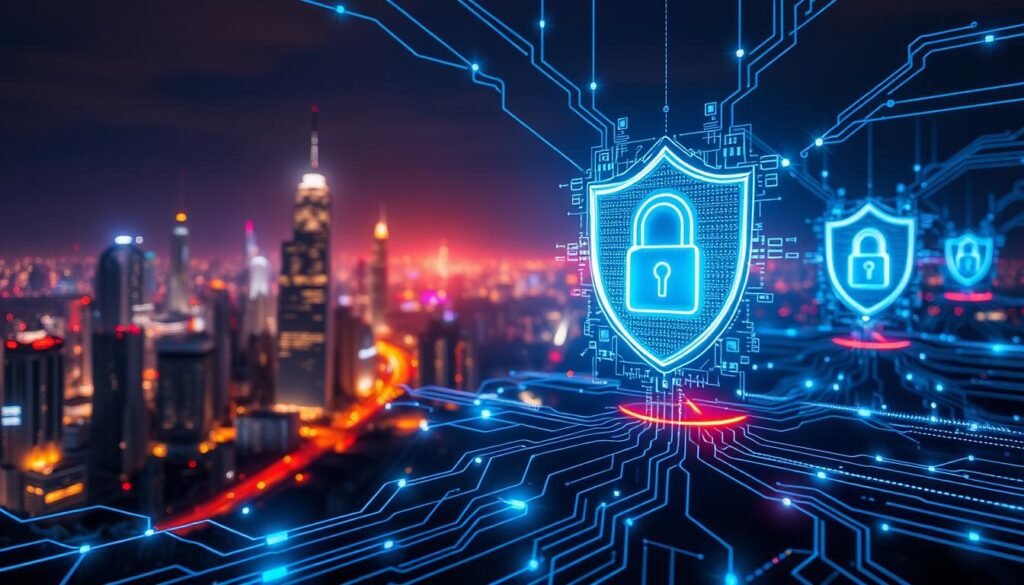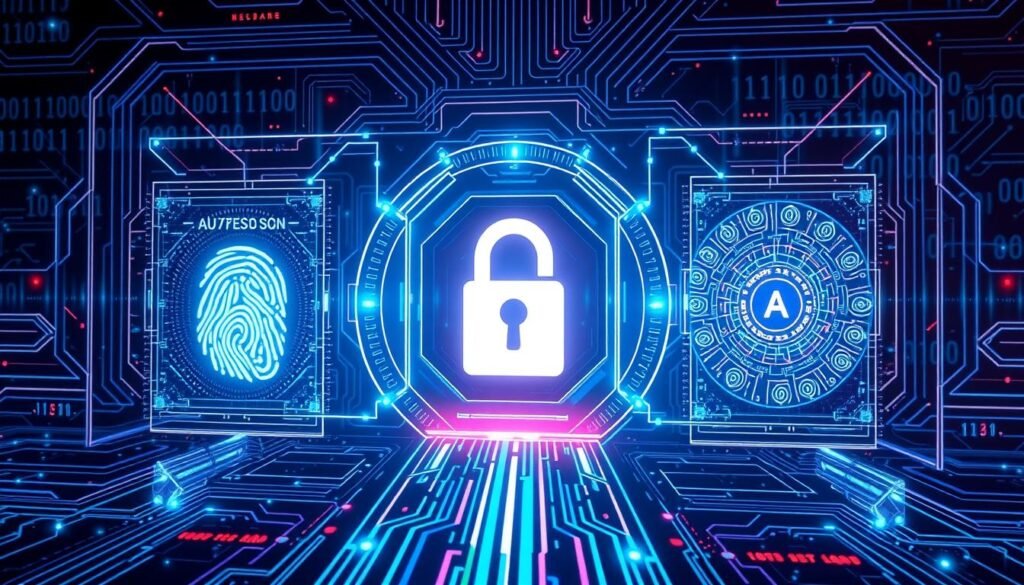The Role of AI in Cybersecurity: Protecting Data in 2024
The role of Artificial Intelligence (AI) in cybersecurity has grown fast. It’s now used in all sectors1. Markets and Markets Research Private Ltd. says the AI in cybersecurity market will hit USD 13.80 billion by 2028. This shows how vital AI is for keeping our digital world safe1.
But, the rise of “Dark AI” has also brought faster and smarter cyber attacks. Attackers use real tools and valid info to hide in plain sight1.
Key Takeaways
- AI-driven cybersecurity tools use machine learning and more to boost security1.
- AI can handle more data than humans, leading to quicker threat detection and response1.
- AI helps in many ways, like finding threats, managing vulnerabilities, and helping analysts1.
- Tools like CrowdStrike Falcon and Charlotte AI use AI to protect us with advanced analytics1.
- AI is key for fighting off complex cyber threats in 2024 and later1.
Understanding AI’s Evolution in Cybersecurity
Artificial Intelligence (AI) has become a key part of modern cybersecurity. This change is due to the rapid growth in data and the increasing complexity of cyber threats2. Important AI tools for protecting data include machine learning, predictive analytics, natural language processing (NLP), and robotic process automation (RPA). These tools help us stay ahead of cyber threats.
Current State of AI Security Solutions
AI and machine learning have been important in cybersecurity for years. Recently, generative AI has gotten a lot of attention3. Companies like Trend Micro and Normalyze use AI to better manage risks and protect data3. Also, new solutions like Torq’s “HyperSOC” use hyper-automation to make incident response faster3.
Key AI Technologies Driving Protection
AI-powered solutions are great at finding and fighting threats2. They can spot real attacks and avoid false alarms, focusing on the most dangerous threats2. AI also helps catch phishing emails and simulates social engineering attacks to prepare us better2. This quick analysis helps contain threats fast, making AI very important in cybersecurity.
Market Growth and Industry Adoption
The market for AI-based cybersecurity products is growing fast, expected to reach $135 billion by 20302. Industry leaders see AI as a game-changer, making it a key advantage3. By 2024, spending on AI for cybersecurity is expected to hit $46.3 billion, showing how widely AI is being adopted4.
“AI is seen as an augmentation to human security analysts, not a replacement. The technology’s impact on cybersecurity is transformative, say industry leaders.”
AI in Cybersecurity 2024: Emerging Trends and Technologies
In 2024, the role of AI will be key in making cybersecurity better and keeping data safe online. New trends include quick threat detection and response, and using predictive analytics to spot cyber threats before they happen. Automation, better authentication, and identifying phishing attacks are also important. Plus, securing the Internet of Things (IoT) is a big focus5.
AI helps create security systems that can change as threats evolve. This keeps cybersecurity strong against new threats. Startups in AI security have raised over $1.4 billion, showing big growth and investment in this area6.
Trending Tools and Technology
Traction Technology is a leading platform that helps big companies find and use new technologies, like AI in cybersecurity. It offers tools for working with startups, making it easier to find and track new technologies. It also gives insights on startup funding and growth, helping companies make smart choices6.
Traction Technology makes it easier for big companies to start digital transformation projects. It also helps reduce the risks of using new technologies. The Traction Report keeps you updated on 24 startups to watch in 20246.
AI is already helping in cybersecurity, like detecting attacks and improving IT security teamwork. It’s also helping to solve the shortage of cybersecurity experts. To use AI well, it’s important to work together with AI systems and human analysts and to make sure AI is clear and explainable5.
Machine learning models can look at a lot of data to find unusual patterns, helping to spot new threats. AI helps in monitoring and hunting for threats, making it easier to stop data breaches and cyberattacks. This makes responding to security breaches faster7.
Future trends include AI that hunts for hidden threats and AI that creates fake systems to catch attackers. These advancements will make cybersecurity even better7.

As AI in cybersecurity grows, companies must keep their AI models up to date. This is key to defending against new threats. Working together with AI and human expertise is essential for tackling the digital world’s challenges5.
Enhanced Threat Detection Through Machine Learning
AI is playing a bigger role in keeping our digital world safe. Machine learning helps us spot and tackle security threats in new ways. It looks at lots of data to find patterns and oddities that old methods miss8.
Pattern Recognition and Anomaly Detection
AI tools are great at finding hidden patterns and odd behaviors that might mean trouble8. They keep learning from new data, so they can catch sneaky threats that others might miss8. This quick action helps protect our important data and keeps our systems safe8.
Real-time Monitoring Capabilities
AI tools watch how users act and spot oddities, stopping threats right away89. They use smart algorithms to learn what’s normal and what’s not, helping catch security problems fast9.
Automated Response Systems
AI security systems can handle security problems on their own, saving time and effort8. They use machine learning to quickly figure out what’s happening, decide what to do, and act fast8. This quick action is key in today’s fast cyber world10.
“AI-powered security solutions are transforming the way we detect and respond to cyber threats, enabling organizations to stay one step ahead of bad actors.”
| AI-Powered Security Solution | Key Capabilities |
|---|---|
| IBM QRadar Advisor with Watson | Leverages machine learning and natural language processing to automatically identify and prioritize security incidents. |
| Splunk User Behavior Analytics | Utilizes AI algorithms to detect advanced threats and anomalies in user behavior and network activity. |
| LogRhythm’s NextGen SIEM Platform | Combines machine learning, behavioral analytics, and automated response to identify and mitigate security incidents. |
Predictive Analytics and Proactive Defense Strategies
In the fast-changing world of cybersecurity, AI is key for staying safe. It uses past data to predict threats and help teams defend better. AI can forecast future attacks and vulnerabilities, enabling security teams to strengthen their defenses and implement preventive measures before breaches occur.11 This way, businesses can lower the risk of cyber attacks and use resources wisely.
AI keeps getting better at fighting cybercrime. As hackers use AI for smarter attacks, AI-powered defense systems can keep up, stopping threats fast.11 This ongoing battle between AI offense and defense is a big challenge for 2024.11
AI can look through lots of data to find signs of cyber threats.11 It spots unusual activities, helping teams respond quickly and block threats.11 This quick action is key against today’s smart cyber attacks.
AI can also help plan better defense strategies.11 It lets companies get ready for new threats, so they can protect themselves before damage happens.11 This foresight is a big advantage in fighting cybercrime.
As AI in cybersecurity grows, companies using it will be safer. By using predictive analytics and proactive defense, we can stay ahead and protect our digital world.11

“AI has surpassed previous predictions in cybersecurity, becoming a vital tool for threat detection and reducing cyber risks.”12
AI-Powered Authentication and Access Management
Artificial Intelligence (AI) is changing how we protect data. It uses advanced tech like biometrics and identity checks to keep information safe. AI helps fight off identity threats, making our digital world more secure13.
Biometric Security Integration
AI uses machine learning to watch how we interact with computers. It looks at things like how we type and when we log in. This makes it harder for hackers to get into our systems13.
Behavioral Analysis Tools
AI tools watch how we act online. They learn what’s normal and spot when something’s off. This helps keep our data safe by adjusting who can access it13.
Identity Verification Systems
AI checks who we are using face scans and fingerprints. It also figures out how risky each login is. This makes our online world safer14.
AI has made identity protection much better. It helps us manage who can access our systems and keeps us safe from threats13. AI is key to keeping our digital lives secure15.
The need for AI in security will only grow. The future might include AI that predicts threats and keeps our data safe14.

“AI-driven IAM and IGA help organizations elevate user experience, improve operational efficiency, and ensure enhanced security.”
Deep Learning for Malware Detection
Cyber threats keep getting smarter, making deep learning in malware detection more important. Deep learning is great at spotting complex patterns in bad software16. It uses algorithms to look through lots of data to find new malware, even if it’s hidden16.
Deep learning is now a big deal in fighting malware. It can learn from big datasets, making it better at telling good files from bad ones17. This means fewer false alarms that can mess up important work17. Different types of deep learning models, like RNNs and CNNs, are being used to fight malware17.
Experts are coming up with new ways to fight even the sneakiest malware16. These systems keep learning from new data, so they can keep up with malware’s changes16.
| Malware Detection Approach | Technology Frameworks |
|---|---|
| Static, Dynamic, and Hybrid | Machine Learning, Deep Learning, and Hybrid Frameworks |
As cyber threats get more complex, deep learning is key in fighting malware17. It helps security experts keep up with cyber threats, protecting data and systems17.
“Deep learning models have gained significance in malware detection due to their ability to automatically learn features from large datasets.”17
AI in Network Security and Monitoring
As our digital world gets more complex, AI is key in keeping our networks and data safe. AI helps us understand traffic patterns, spot threats, and handle security issues18.
Traffic Analysis and Threat Identification
AI systems can quickly sort through huge amounts of network data. They find odd patterns and possible security risks with great speed18. They use smart learning to catch complex cyber threats like malware and DDoS attacks very well18.
Automated Security Protocol Updates
AI keeps our networks safe by updating security rules and fixing weak spots automatically19. This makes security work smoother and frees up cybersecurity teams to focus on big tasks.
Incident Response Automation
When a security breach happens, AI systems quickly jump into action. They figure out the problem, decide what to do, and start fixing it right away19. This fast action helps protect our important data and systems19.
Using AI in network security makes our systems stronger against cyber threats. It helps us find and fix problems before they get worse1819.
| AI Capabilities in Network Security | Benefits |
|---|---|
| Real-time traffic analysis and threat identification | Improved threat detection and faster response times |
| Automated security protocol updates | Streamlined security operations and reduced workload for cybersecurity teams |
| Incident response automation | Minimized impact of security incidents and faster recovery |
“AI-powered network security solutions are revolutionizing how we analyze traffic patterns, identify threats, and respond to security incidents.”
As autonomous security systems and cyber-AI resilience grow, AI’s role in AI cybersecurity 2024 will be even more important. It will help protect our digital world and keep our networks safe1819.
Challenges and Risks in AI-Based Security
AI-powered cybersecurity solutions bring big benefits but also new challenges. The complex nature of AI algorithms can sometimes hide how data is processed. This might lead to not following data protection rules20.
There are worries about AI bias, misuse of data, and keeping AI security decisions transparent and accountable20. It’s a big challenge for companies to balance innovation with ethics and follow rules when using AI in security.
The risks of AI-based security systems are many20. Keeping AI models safe from tampering is key, as it can make them less effective20. AI security also stops attackers from using AI for bad things20.
But, AI-enhanced social engineering attacks and API vulnerabilities are getting smarter. These are new threats that companies must face21.
To tackle these issues, businesses need to focus on strong security for their AI systems20. They must protect data, keep AI models safe, and be open about AI decisions20. It’s also important to keep up with the latest AI security threats and best practices21.
As AI in cybersecurity grows, tackling these challenges and risks is key for companies to fully benefit from this technology20. By tackling AI security’s complexities and weaknesses, businesses can make their cybersecurity stronger. This will help build trust in AI technologies21.
Conclusion
AI is changing how we protect data in 2024. It helps spot threats early, with over 200,000 alerts daily for mid-sized companies22. AI can quickly respond to cyber threats, reducing damage and time to fix issues22.
As cyber threats get more complex, AI helps by analyzing different data sources. This gives a clear view of threats, helping us defend better22.
AI also grows with our digital world, keeping security strong as more devices connect22. It learns from new data and past attacks, getting better at spotting threats over time22. This will make our digital world safer in 2024 and beyond.
But, we must face the ethical and legal issues of AI in cybersecurity. AI is changing jobs, with 88% of ISC2 members feeling its impact23. Yet, 35% of cybersecurity pros say AI affects their daily work23.
We need to use AI wisely, balancing its benefits with the need to protect data and human skills. By creating strong policies on AI’s use and deployment23, we can unlock AI’s power in cybersecurity while addressing its risks.





March 7, 2025 @ 2:11 am
I don’t think the title of your article matches the content lol. Just kidding, mainly because I had some doubts after reading the article.
March 16, 2025 @ 2:07 am
I don’t think the title of your article matches the content lol. Just kidding, mainly because I had some doubts after reading the article.
June 27, 2025 @ 4:58 am
I don’t think the title of your article matches the content lol. Just kidding, mainly because I had some doubts after reading the article.
August 22, 2025 @ 3:22 am
Your point of view caught my eye and was very interesting. Thanks. I have a question for you. https://accounts.binance.com/register?ref=P9L9FQKY